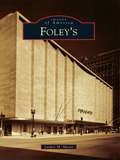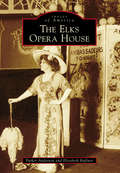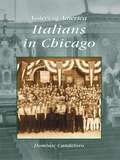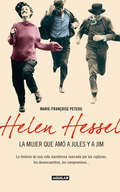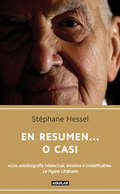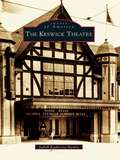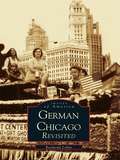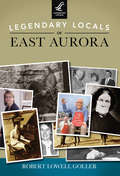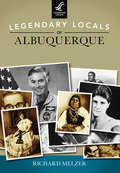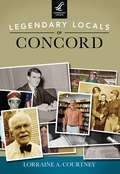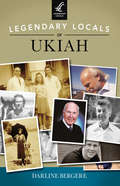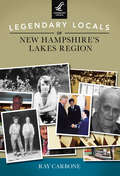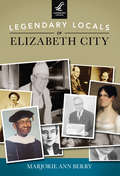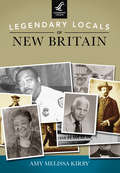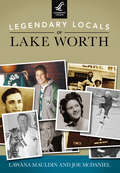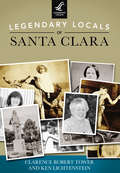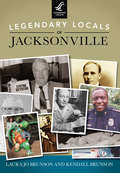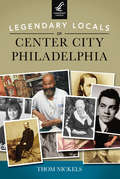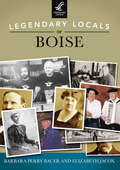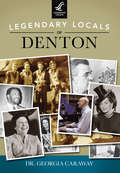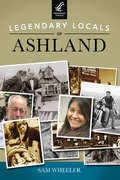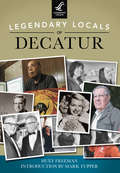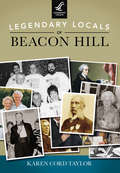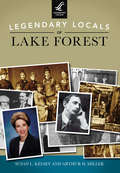- Table View
- List View
Foley's (Images of America)
by Lasker MeyerThe story of Foley's began in Ireland in the late 1800s when William L. Foley set sail for America. Ambition led him to Houston, where he opened a store and hired his two nephews, Pat C. and James. The nephews quickly felt an entrepreneurial urge to run their own store, so their uncle gave them $2,000 to get started. On February 12, 1900, the Foley Brothers Dry Goods Company at 507 Main Street opened for business. Approximately 44,000 residents visited the store that day, and sales of $128.29 were tabulated. Soon after Spindletop was discovered, Robert I. Cohen of Galveston bought the Foley Brothers company for his son George S. Cohen to operate. Cohen, along with the aid of six of the eight Meyer brothers from Galveston, built it into the largest store in Texas. In 1945, Fred Lazarus, from the department store clan in Ohio, came to Houston to visit his son at Ellington Field. He saw Houston's potential, and in 1946, Foley Brothers became Foley's, owned by Federated Department Stores.
Elks Opera House, The (Images of America)
by Parker Anderson Elisabeth RuffnerFor over 100 years, the Elks Opera House has been a landmark of the cultural scene in Prescott, Arizona, and the western United States. In 1904, the people of Prescott raised $15,000 toward a performance hall to be included in the Elks Building. The original structure featured opera boxes that were later removed to adapt to the demands of motion pictures, and the entire proscenium arch was covered with wood paneling. In 2010, the Elks Opera House Foundation completed major renovations to restore the original 1905 grandeur of the theater and the 1928 marquee, which was paid for by grants from local charitable foundations, Arizona historic preservation funds, and generous participation by businesses and individuals. The Elks Building was listed in the National Register of Historic Places in 1978.
Italians in Chicago: 1945-2005 (Voices of America)
by Dominic CandeloroThe stories of Chicago's Italian communities are an important part of the rich and diverse mosaic of Chicago history. As a rail center, an industrial center, and America's fastest growing major city, Chicago offered opportunities for immigrants from all nations. Italians in Chicago presents an intriguing narrative record of the earliest beginnings of Italian communities in the city, going back to the 1850s. It explores the lives of ten significant members of the Chicago Italian-American community.This book is a collaborative, cumulative effort, and gives glimpses and echoes of what occurred in the Italian-American past in Chicago. Including vintage images and tales of such individuals as Father Armando Pierini, Anthony Scariano, and Joe Bruno, and groups such as the Aragona Club and the Maria Santissima Lauretana Society, this collection uncovers the challenges and triumphs of these Italian immigrants.
Helen Hessel, la mujer que amó a Jules y Jim: La historia de una vida asombrosa marcada porlas rupturas, los desencuentros, los compromisos...
by Marie-Françoise PeteuilHelen Hessel, una vida extraordinaria. La historia de una vida asombrosa marcada por las rupturas, los desencuentros y los compromisos. Pintora, periodista, escritora, musa, feminista, resistente, traductora o filósofa... No es fácil reducirla a una sola identidad. Helen Hessel encauzó su vida haciendo gala de una fuerza y una audacia insólitas. Se casó dos veces con el escritor judío-alemán Fran Hessel (Jules), amigo íntimo de Walter Benjamin, y se divorció otras dos, y con él tuvo dos hijos: Ulrich y Stéphane. Mantuvo una relación extramarital con el también escritor Henri-Pierre Roché (Jim), un amor loco que se prolongó durante quince años. La existencia de Helen se construye en función de rupturas, desviaciones y compromisos. Peligrosa, provocadora, insoportable, vital, abandonó a su familia, fue granjera, construyó una casa en el Báltico, convirtió su casa de París en un bastión de la intelectualidad alemana, viajó solaa Berlín para rescatar a su ex marido de la muerte y junto a Aldoux Huxley hizo un llamamiento a las mujeres alemanas para que abandonaran el país. Marie-Françoise Peteuil construye, gracias a una excelsa documentación y al valioso testimonio de su hijo, Stéphane Hessel, autor de ¡Indignaos!, la trayectoria vital de una mujer excepcional que amó hasta la locura y que por encima de todo fue siempre fiel a ella misma. Helen Hessel es el álter ego del personaje de Catherine de la clásica película de Truffaut Jules y Jim.
En resumen... o casi
by Stéphane HesselUn compendio de experiencias ejemplares para respaldar un compromiso, una manera de enfrentar la vida. «Esta acumulación de memoria humana constituye un tesoro de sentido. Haber atravesado un siglo lleno de inventos, esperanzas y horrores, y haber vivido plenamente esta aventura es lo que me da legitimidad. Porque tal vez he recibido de la vida una deuda de sentido, y hoy puedo permitirme pagarla con mi testimonio.»Stéphane Hessel En En resumen... o casi el agitador de conciencias Stéphane Hessel aborda de forma magistral los temas de la indignación y sus límites, la compasión, el amor, la admiración, la resiliencia, la reivindicación de la dignidad, la fuerza de las palabras, el compromiso político o la democracia para transmitir a las nuevas generaciones que es preciso luchar a diario por recuperar la dignidad y por construir las bases de un futuro común más justo y accesible para todos. Una obra reveladora y necesaria en la que la voz de Hessel se entremezcla con versos y confidencias, con opiniones y recuerdos que configuran la trayectoria intelectual y personal de un hombre bueno. Reseñas:«Una autobiografía intelectual, emotiva e inclasificable.»Le Figaro Litteraire «Las palabras de Stéphane Hessel desbordan el marco de un simple libro. Son una llamada a abrir los ojos y despertar nuestras conciencias. Este libro, por tanto, no es una autobiografía en sentido estricto, no mira hacia el pasado. Es una invitación a tener valor. Recoge unas experiencias que han resultado ejemplares y útiles para respaldar un compromiso, una manera de enfrentarse a la vida.»Maren Sell (editor francés)
Zara: Visión y estrategia de Amancio Ortega
by David MartínezLas claves del mayor milagro empresarial de las últimas décadas solo se pueden comprender conociendo a su creador, Amancio Ortega. El espectacular crecimiento de Zara es el fenómeno empresarial más destacado de la historia reciente de nuestro país. Nacida en un momento de clara decadencia de la industria textil, Zara se basa en un modelo de negocio que se ha demostrado imbatible, y que constituye un caso único, estudiado y admirado en todo el mundo. Su vertiginosa expansión y su éxito están inseparablemente ligados a la figura de su fundador, Amancio Ortega, y a su visión única del cliente y del negocio. Zara analiza cuáles son los principios y estrategias que a lo largo de las diferentes etapas de consolidación y crecimiento de la compañía han inspirado a Amancio Ortega a tomar las decisiones claves en cada momento y que constituyen la base de esta multinacional. Desde la gestión de las tiendas hasta el sistema de diseño y aprovisionamiento de Inditex, el libro recorre todos los aspectos de una brillante trayectoria que está estrechamente vinculada a la biografía y la personalidad excepcionales de su fundador, y a su forma de entender a los clientes y de gestionar su empresa. Los expertos opinan...«Por fin un libro equilibrado entre la historia de su patrón y la de la empresa que creó. Un libro interesante, repleto de datos inéditos, pero, sobre todo, valiente, ya que hay que serlo para poder escribir una historia optimista de una gran empresa española en los tiempos que corren.»José Luis Nueno, catedrático de Marketing del IESE «Pasar por delante de los amplios escaparates de Zara en Manhattan nos lleva a plantearnos ¿cómo ha llegado esta empresa a alcanzar su enorme éxito internacional, y cuáles son las claves de la personalidad de quien ha impulsado esta aventura? El libro de David responde a estas preguntas con enorme claridad.»Emili J. Blasco, corresponsal de ABC en Estados Unidos «Si alguien es digno de la admiración general es Amancio Ortega, que ha sido capaz de transformar todo un sector a nivel mundial. Cualquier esfuerzo encaminado a acercarnos a su figura, tal como realiza David Martínez, es un gran beneficio para todos los interesados en aprender a aportar valor de forma innovadora.»Juan Ramis, profesor de Innovación de ESADE
Keswick Theatre, The (Images of America)
by Judith Katherine HerbstThe Keswick Theatre, located just outside Philadelphia, opened in 1928 in an era when four thousand similar structures were in various stages of design and construction across the country. Vaudeville was in its final days and film was just being born. Designed by acclaimed architect Horace Trumbauer, the theater evolved into the area's premier movie house. When the theater was threatened with demolition in the early 1980s, the Glenside Landmarks Society was formed with the hopes of restoring the building to its former grandeur. Today, operating as a commercial venture, it is one of the most acclaimed concert halls in the Philadelphia area. The Keswick Theatre celebrates this historic landmark through vintage images and recognizes the dedicated community members who have kept its doors open.
German Chicago: Revisited (Images of America)
by Raymond LohneGerman Chicago Revisited follows the photographic study which began in German Chicago: The Danube Swabians and the American Aid Societies. With this latest title in the Images of America series, historian and photographer Raymond Lohne crafts another volume about a group of American citizens who preserve their rich heritage with unwavering effort.This book will give readers a glimpse into the life of a close-knit and highly active community, revealing groups like the Kerneir Pleasure Club, the American Aid Society, and the Society of the Danube Swabians. The German musical life of the city is featured, as is the Karneval season and other year-round festivities and celebrations of the Deutsch-Americans of Chicago and its suburbs.
Legendary Locals of East Aurora (Legendary Locals)
by Robert Lowell GollerNestled along the banks of Cazenovia Creek, East Aurora is a cultural center of western New York State that has flourished because of the diverse talents of its people. Native Americans lived in East Aurora for thousands of years before the first settlers came to the area in 1804. One of the first pioneers, Martha Richardson Adams, carried her infant child on horseback all the way from Massachusetts. East Aurora grew rapidly after the War of 1812, evolving into an important business center south of Buffalo. By the 1880s, the village had become a horse-racing capital, where thousands came to Cicero Hamlin's farm to get a glimpse of his legendary horse, Mambrino King. As the century came to a close, hundreds of creative types were drawn to the Roycroft Campus, where Elbert Hubbard had established an arts and crafts colony. Despite modern developments, East Aurora remains a small village at heart, where the owners of the barbershop, bookstore, pharmacy, coffee shop, theater, and old-fashioned 5 & 10 still greet you at the door.
Legendary Locals of Albuquerque (Legendary Locals)
by Richard MelzerSpanish settlers founded Albuquerque in 1706, making it the third of only four villas (towns) in colonial New Mexico. Located in the Rio Abajo along a wide turn on the Rio Grande, the settlement developed from a small farming community into New Mexico's largest, most modern city. Many notable men and women participated in this remarkable growth, lending their talents and sacrificing their time, energy, and sometimes their very lives. Dozens of these legendary figures are portrayed in this unique book, with chapters devoted to those who played important roles in politics and diplomacy; the military; law and order; religion and education; art and literature; culture and entertainment; business and tourism; health, science, technology, and space; and sports. A final chapter describes several of Albuquerque's sung and unsung heroes. The result is a collage of a Western city filled with diversity, tradition, and cultural pride.
Legendary Locals of Concord (Legendary Locals)
by Lorraine A. CourtneyThe land now called Concord was originally inhabited by the Abenaki people and the Penacook tribe. Concord's first settlers, such as Ebenezer Eastman, began laying out the Plantation of Penacook, as it was known in 1725, along the fertile fields of the Merrimack River. It was incorporated in 1734 as Rumford and then renamed to Concord by Gov. Benning Wentworth in 1765. Concord experienced a surge in transportation and manufacturing in the 19th century, producing the Concord Coaches, Prescott Pianos, and steam boilers. As Concord celebrates its 250th anniversary, the city flourishes as the state capital and has a thriving community of restaurants, entertainment, and culture for all to enjoy. It retains its town sensibility as it plans for the continued growth of the local economy. Today's civic leaders, like Byron Champlin and James Carroll, work conjointly with business leaders, such as Tom Arnold of Arnie's and Juliana Eades of the New Hampshire Community Loan Fund, to build and enhance Concord's cultural, social, and economic identity.
Legendary Locals of Ukiah (Legendary Locals)
by Darline BergereMountains. Trees. A lake. What makes a city, town, or village come to life are the people--those who have gone before and those who are there today. They are what shape and build the community of Ukiah. With their personalities, foibles, compassion, and humor, some of these influential men and women stand out by design and some quietly exist on the sidelines. Utah Haley, a disabled veteran, drives other veterans to doctors' appointments. Rick Paige is always the first on-scene to help in a disaster. Spencer Brewer started the "Sundays in the Park" free concerts more than two decades ago. Ukiah is a town that supports its businesses, and those same local businesses give back to the community in many ways. Shannon Riley of Shoefly and Sox holds an annual shoe drive. Jan Hoyman and Doug Browe of Hoyman Browe Studios donate countless pieces of their work to charitable auctions. Ann Kilkenny of Mendocino Book Company gives time and assistance to local organizations. Marty Lombardi, who spent 40 years with Savings Bank of Mendocino, was always lending a helping hand to local nonprofits.
Legendary Locals of New Hampshire's Lakes Region (Legendary Locals)
by Ray CarboneThere are few places in America that have such a rich variety of landscape and scenery as the Lakes Region of New Hampshire: from the summer calm of Squam Lake to the robust white winter mountaintops of the Gunstock Mountain Resort. So it is no surprise that the people who call it home reflect the same wide palette of humankind--from the pre-Revolutionary War surveyors who first marked their initials on a rock at Weirs Beach to Bob Lawton, the current owner of the world's largest arcade; from one of George Washington's inner circle to Ernest Thompson, the award-winning author of On Golden Pond. The Lakes Region draws them--or grows them--all, because it has it all.
Legendary Locals of Elizabeth City (Legendary Locals)
by Marjorie Ann BerryElizabeth City is rich in legend and lore. The pirate Blackbeard was a frequent visitor to the area, selling his ill-gotten goods to a willing populace. The Wright brothers made Elizabeth City the first leg of their trips to Kitty Hawk, and they bought materials to build their flying machine from Kramer Brothers, a local lumberyard. Champion nine-ball player Luther "Wimpy" Lassiter was born and died here. Young "Beautiful Nell" Cropsey was murdered in 1901; her death is the town's most enduring mystery. Newspaperman W.O. Saunders, editor of the Independent, was known nationally after he walked down New York's Fifth Avenue in pajamas to protest uncomfortable work attire. Young Tamsen Donner, a member of the ill-fated Donner Party, was a teacher here in the 1830s. Fred Fearing's Rose Buddies welcomed boaters to Elizabeth City with homegrown roses and wine and cheese parties. He has entertained Walter Cronkite and Willard Scott, among other luminaries. These are just a few of the stories, mysteries, and legends of Elizabeth City's past and present.
Legendary Locals of New Britain (Legendary Locals)
by Amy Melissa KirbyNew Britain began in 1754 as an ecclesiastical society and farming village, and with few natural resources, was transformed into a modern industrial city by the time of its incorporation in 1871. Attracting waves of immigrant workers and entrepreneurs, this became a diverse but unified community in which people of all ethnicities worked together, served together in times of war, and even played together on the baseball fields. Legendary Locals of New Britain includes remarkable residents among the early inhabitants and settlers; the people and institutions that brought New Britain to cityhood; artists and entertainers; famous or leading immigrants; sports legends; and men and women who have otherwise made their mark on New Britain, the nation, or the world.
Legendary Locals of Lake Worth (Legendary Locals)
by Lawana Mauldin Joe McdanielDuring the early 1900s, a large reservoir built to provide water for Fort Worth, Texas, also opened up opportunities for businesses to develop. Casino Beach, Casino Ballroom, and a large bathhouse became popular spots for thousands. A nearby village, with increasing population, soon had a small school, churches, and other establishments. With nearby Jacksboro Highway running from downtown Fort Worth past the beach area, gambling increased, as did gangster activity. After a long while, with much intervention, these unlawful situations became history. Legendary Locals of Lake Worth spotlights the founders of the small village and features individuals who impacted the area--many for the better, others for the worst. Some may never have received proper recognition until this book's acknowledgment of them.
Legendary Locals of Santa Clara (Legendary Locals)
by Clarence Robert Tower Ken LichtensteinThe city of Santa Clara lies in the very heart of the Santa Clara Valley, directly south of San Francisco Bay. It is the home base of the internationally famous Santa Clara Swim Club, the equally famous synchronized swim team the Santa Clara Aquamaids, the International Swim Center, and the San Francisco 49ers professional football team. It boasts world-class parks, theaters, museums, acting groups, a featured chorale, a nationally ranked drum and bugle corps, a major theme park, a convention center, and a first-class hotel system for those who wish to visit. Legendary Locals of Santa Clara celebrates the people who guided all of this to its realization.
Legendary Locals of Jacksonville (Legendary Locals)
by Kendall Brunson Laura Jo BrunsonSince Europeans first settled along Jacksonville's riverbanks in the 16th century, the area has been a diverse community that thrives not only on commerce, music, and the arts but also on the advantages of a subtropical climate and waterside lifestyle. The city grew up around a crossing point for cattle in the St. Johns River and first became known as Cowford. The Great Fire of 1901 left 10,000 people homeless but not defeated. The ashes gave birth to a new era with strong architecture and a new resolve. Considered a friendly town for African Americans, Jacksonville was home to Harlem Renaissance artists as well as civil rights leaders. A bit laid back, the city has still managed to be on the cutting edge--it was the home of the Navy's Blue Angels as well as Southern rock and one of the country's first skateboard parks.
Legendary Locals of Center City Philadelphia (Legendary Locals)
by Thom NickelsPhiladelphia is a hard mistress when it comes to honoring native talent, and the city has more than its fair share of notable figures. Consider colorful politicians like Frank Rizzo and Richardson Dilworth, international celebrities like Grace Kelly, sports legends like Connie Mack, Philadelphia Museum of Art icons like Anne d'Harnoncourt, or national radio personalities like Terry Gross. Business tycoons such as John Wanamaker and Russell Conwell, founder of Temple University, made many contributions to the city. Pearl Buck, author of The Good Earth, and Christopher Morley, America's G.K. Chesterton, created legacies of their own. Other legends like the nearly forgotten Agnes Repplier, a world-famous essayist and contemporary of Henry James, and poet Daniel Hoffman, the designated US poet laureate in 1973-1974, have helped enrich the city's literary reputation. There are Marian Anderson, Mario Lanza, and Hollywood actor Kevin Bacon, whose fame is equaled by his city planner father, Edmund. Architects like Frank Furness, Louis Kahn, and Vincent Kling helped transform the city into an international destination. And there are many notables looming outside the margins of this book, waiting for their day of discovery.
Legendary Locals of Boise (Legendary Locals)
by Barbara Perry Bauer Elizabeth JacoxBoise of the 21st century is very different from the tiny community established in 1863 at the crossroads of the Oregon Trail and the road to the Boise Basin gold mines. Originally known as "Boise City," it existed as a distribution center for supplies and fresh food for miners. The development of irrigated agriculture and the expansion of transportation networks during the 20th century and an influx of pioneers from many regions of the United States helped the city grow into a technology center during the 21st century. Early residents like Tom and Julia Davis helped create a city filled with green parks and walking paths; author and illustrator Mary Hallock Foote brought Boise to the attention of the nation with her writing and illustrations; businessmen J.R. Simplot and Joe Albertson established local businesses that grew to national companies. The music of Curtis Stigers, the literature of Anthony Doerr, and the athletic prowess of Kristin Armstrong have helped focus attention on Boise, which is now recognized as one of the country's most livable communities.
Legendary Locals of Denton (Legendary Locals)
by Dr Georgia CarawayDenton, Texas, was founded in 1857 because residents needed a location near the geographic center of Denton County to house a county seat. The city is located 39 miles north of two larger cities, Dallas and Fort Worth, and the three of them form what is often referred to as the "Golden Triangle." Denton, the peak of that triangle, is the "North Star," and its residents, past and present, certainly are superstars--superstars such as Bob Rogers, the beloved "Piano Man;" Mary Evelyn Blagg Huey, a quintessential leader; and Hal Jackson, an ace war hero and lawyer. Their accomplishments burst forth from the chapters of this book to outshine others with their generosity, talents, skills, community activism, adventurous spirits, energy, civic pride, business acumen, courage, and creativity. Citizens of Denton are proud to say, "Our history defines our community." The images and words between these covers illustrate why it should be added, "And our people define our history."
Legendary Locals of Ashland (Legendary Locals)
by Sam WheelerA century and a half of close-knitted community spirit, independent-mindedness, and a strong sense of stewardship have uniquely melded into present-day Ashland. Behind that patchwork of local ingenuity, artistry, and infamy are the faces of thousands--too many of whom are not mentioned within the pages of this book. There were hundreds of generations of Shasta Native American families that lived off the hills and creeks where Ashland now sprawls, but their abodes were abandoned and replaced by the lumber and flour mills, cleared streets, and painted homes of Ashland Mills. The sense of spirit and enthusiasm instilled by Ashland's early settlers bred the town's participation in the Chautauqua cultural movement, the remnants of which harbor Ashland's world-renown Oregon Shakespeare Festival, which paved the way for a former mill town's future prosperity. That spirit of ingenuity and artistry continues to shape Ashland and attracts hundreds of thousands of visitors annually to the quaint town nestled below the mighty crest of Siskiyou Pass along the Oregon-California border.
Legendary Locals of Decatur (Legendary Locals)
by Huey Freeman Mark TupperA working-class city of 75,000 people on the banks of the Sangamon River and its largest lake, Decatur has a reputation for outstanding individuals with a strong community spirit and an unashamed sense of patriotism. To borrow a phrase from Adm. Chester Nimitz, in Decatur, uncommon dedication is a common virtue. Harold Miller fought at Iwo Jima with a Marine tank battalion, before serving 32 years on the Decatur Police Department. Wayne and Leslie Kent, ministers at First Christian Church, risked their freedom to bring music and encouragement to oppressed believers in the Soviet Union and Poland. George Halas, a Navy veteran, was player-coach for the Decatur Staleys football team (later the Chicago Bears), a charter franchise in the professional association that would become the NFL. Bob Fallstrom, a World War II soldier before working as a newspaper reporter and editor in Decatur for more than 65 years, has promoted numerous community causes. Legendary Locals of Decatur pays tribute to those who have made this community truly unique.
Legendary Locals of Beacon Hill (Legendary Locals)
by Karen Cord TaylorIn the 1600s, William Blaxton set up his farmstead on Beacon Hill because it was far from the bustle of the city. John Hancock's uncle Thomas Hancock built his mansion on the hill in the 1700s so he could enjoy a rural lifestyle. In the early 1800s, future mayor of Boston Harrison Gray Otis moved to Beacon Hill because it was the new and fashionable neighborhood he was helping create. Louisa May Alcott, in the 19th century, and Robert Frost, in the 20th, lived on the hill because the literary set loved the neighborhood's picturesque streets and close quarters that made it easy to get together for conversation. The 9,000 residents who live in this small, urban neighborhood of Boston today appreciate its walkability, convenience, quirkiness, and neighborliness. The historic architecture, ever-burning gas lamps, rugged bricks, and one-of-a-kind shops prove that the best of the past can live comfortably with the novelty of the present.
Legendary Locals of Lake Forest (Legendary Locals)
by Arthur H. Miller Susan L. KelseySince the 1850s, Lake Forest, located 30 miles north of Chicago on Lake Michigan, has been a distinctive suburb. It has been a retreat from the diseases, public accessibility, rougher elements, soot, stockyard smells, and general density of bustling city life. For at least five generations, it has been the retreat for Chicago's leading New England-descended families, such as the Farwells, Swifts, and Armours. And for over 150 years, Lake Forest has been the home for a community of educators, merchants, artisans, designers, and a wide variety of estate specialists, the latter from pre-Civil War escaped slaves and Scots and Irish immigrants to today's notable garden and interior artists. Legendary Locals of Lake Forest draws on rare archival images from local and Chicago public and private sources.
